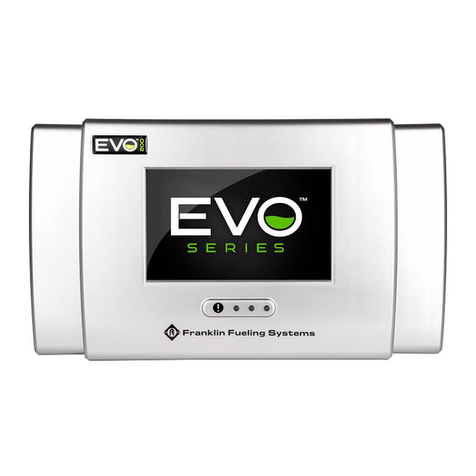
The informaon in this publicaon is provided for reference only. While every eort has been made to ensure the reliability and accuracy of
the informaon contained in this manual at the me of prinng, we recommend that you refer to “franklinfueling.com” for the most current
version of this manual. All product specicaons, as well as the informaon contained in this publicaon, are subject to change without noce.
Franklin Fueling Systems does not assume responsibility and expressly disclaims liability for loss, damage, or expense arising out of, or in any way
connected with, installaon, operaon, use, or maintenance by using this manual. Franklin Fueling Systems assumes no responsibility for any
infringement of patents or other rights of third pares that may result from use of this manual or the products. We make no warranty of any kind
with regard to this material, including, but not limited to, the implied warranes of merchantability and tness for a parcular purpose.
Copyright © 2021 Franklin Fueling Systems, LLC, Madison, WI 53718. All world rights reserved. No part of this publicaon may be stored in a
retrieval system, transmied, or reproduced in any way, including, but not limited to, photocopy, photograph, magnec, or other record, without
the prior wrien permission of Franklin Fueling Systems.
For technical assistance, please contact Franklin Fueling Systems:
franklinfueling.com
3760 Marsh Rd. • Madison, WI 53718 • USA
Tel: USA & Canada +1 800 225 9787 • Fax: +1 608 838 6433
Tel: UK +44 (0) 1473 243300 • Tel: Mex 001 800 738 7610
Tel: DE +49 6571 105 380 • Tel: CH +86 10 8565 4566
Belden is a trademark of Belden Technologies, Inc
EVO is a trademark and FE PETRO, FFSPro, and AUTO-LEARN are registered trademarks of Franklin Electric Company, Inc.
Red Jacket and Veeder-Root are registered trademarks of The Veeder-Root Company
000-2145 r11
Conventions used in this manual
This manual includes safety precauons and other important informaon presented in the following format:
NOTE: This provides helpful supplementary informaon.
IMPORTANT: This provides instrucons to avoid damaging hardware or a potenal hazard to the environment, for example: fuel leakage from
equipment that could harm the environment.
CAUTION: This indicates a potenally hazardous situaon that could result in minor or moderate injury if not avoided. This may also be used to
alert against unsafe pracces.
WARNING: This indicates a potenally hazardous situaon that could result in severe injury or death if not avoided.
DANGER: This indicates an imminently hazardous situaon that will result in death if not avoided.
Operating precautions
Franklin Fueling Systems (FFS) equipment is designed to be installed in areas where volale liquids such as gasoline and diesel fuel are present.
Working in such a hazardous environment presents a risk of severe injury or death if you do not follow standard industry pracces and the
instrucons in this manual. Before you work with or install the equipment covered in this manual, or any related equipment, read this enre
manual, parcularly the following precauons:
IMPORTANT: To help prevent spillage from an underground storage tank, make sure the delivery equipment is well-maintained, that there is a
proper connecon, and that the ll adaptor is ght. Delivery personnel should inspect delivery elbows and hoses for damage and missing parts.
CAUTION: Use only original FFS parts. Substung non-FFS parts could cause the device to fail, which could create a hazardous condion and/
or harm the environment.
WARNING: Follow all codes that govern how you install and service this product and the enre system. Always lock out and tag electrical
circuit breakers while installing or servicing this equipment and related equipment. A potenally lethal electrical shock hazard and the possibility
of an explosion or re from a spark can result if the electrical circuit breakers are accidentally turned on while you are installing or servicing this
product. Refer to this manual (and documentaon for related equipment) for complete installaon and safety informaon.
WARNING: Before you enter a containment sump, check for the presence of hydrocarbon vapors. Inhaling these vapors can make you dizzy or
unconscious, and if ignited, they can explode and cause serious injury or death. Containment sumps are designed to trap hazardous liquid spills
and prevent environmental contaminaon, so they can accumulate dangerous amounts of hydrocarbon vapors. Check the atmosphere in the
sump regularly while you are working in it. If vapors reach unsafe levels, exit the sump and venlate it with fresh air before you resume working.
Always have another person standing by for assistance.
WARNING: Follow all federal, state, and local laws governing the installaon of this product and its associated systems. When no other
regulaons apply, follow NFPA codes 30, 30A, and 70 from the Naonal Fire Protecon Associaon. Failure to follow these codes could result in
severe injury, death, serious property damage, and/or environmental contaminaon.
WARNING: Always secure the work area from moving vehicles. The equipment in this manual is usually mounted underground, so reduced
visibility puts service personnel working on it in danger from moving vehicles that enter the work area. To help prevent this safety hazard, secure
the area by using a service truck (or some other vehicle) to block access to the work area.
DANGER: Make sure you check the installaon locaon for potenal ignion sources such as ames, sparks, radio waves, ionizing radiaon,
and ultrasound sonic waves. If you idenfy any potenal ignion sources, you must make sure safety measure are implemented.





























